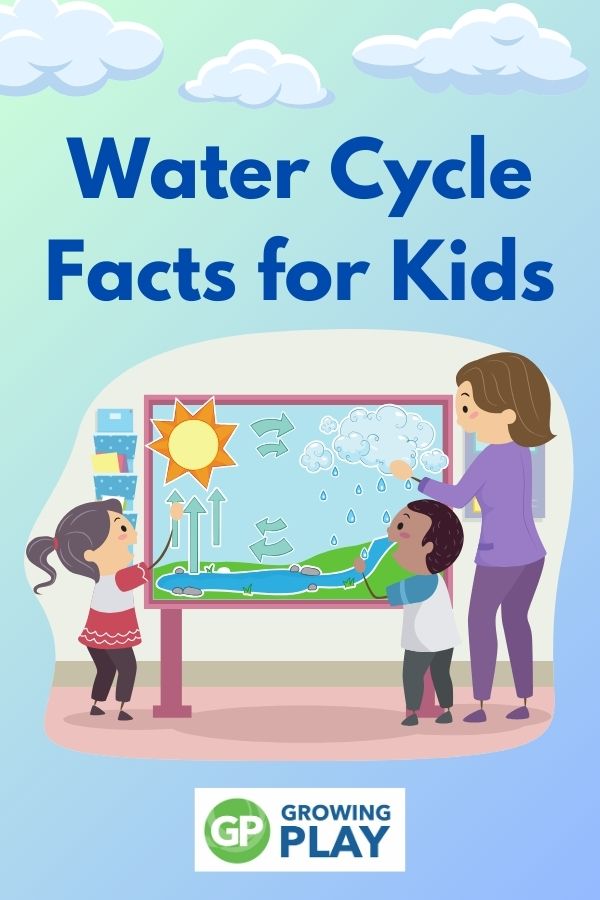Water Cycle Facts for Kids

Water is an incredible substance, and the water cycle plays a significant role in our planet’s health. If you’ve ever wondered about the journey water takes on earth or how we get those refreshing drops from the sky, this blog post on “Water Cycle Facts for Kids” is just for you! So, put on your learning cap as we dive into the mesmerizing world of the water cycle. 🌍💧
10 Key Water Cycle Facts for Kids:
- The water cycle is the continuous movement of water from Earth’s surface to the atmosphere and back.
- Water can exist in three states: solid (like ice), liquid (as in a glass), and gas (steam or vapor).
- The sun’s heat causes liquid water to evaporate from bodies of water, turning it into water vapor.
- As water vapor rises and cools, it forms tiny droplets that come together to make clouds.
- When water droplets in clouds become heavy, they fall as rain, snow, sleet, or hail.
- After falling, water on the ground becomes surface runoff, eventually flowing back into oceans.
- Plants release water vapor into the atmosphere through a process called transpiration.
- Human activities, like burning fossil fuels, can impact the water cycle and increase global warming.
- Only 2.5% of the world’s water is fresh water, emphasizing the importance of water conservation.
- Earth is often called the ‘Blue Planet’ due to the vast bodies of water covering about 71% of its surface.
WANT MORE FUN FACTS FOR KIDS?
Check 100 fun facts for kids here and browse all the other topics at the bottom of the post. Expand this activity and download the Water Cycle Word Search puzzle for free.
Understanding the Water Cycle
Water on Earth is continuously in motion. This continuous movement of water from the earth’s surface to the atmosphere and back is known as the hydrologic cycle or simply, the water cycle. Fun fact: this cycle has been going on for billions of years!
Earth’s Surface and Water
The majority of the water on Earth’s surface is stored in oceans. But water can also be found in rivers, lakes, and even underneath the ground in what we call ‘groundwater’. It’s pretty amazing how much water our planet holds!
Different Forms of Water in the Cycle
Water can exist in three different states: solid (like ice), liquid (like the water in a glass of water), and gas (like steam from hot water).
How the Sun Powers the Cycle
The sun’s heat is super important for the water cycle process. When the sun heats up bodies of water like oceans, the liquid water turns into water vapour, rising into the air. This process is known as evaporation.
Formation of Clouds
As water vapour rises, it cools down. It then changes back into tiny water droplets which form clouds in the sky. This process is called condensation. The next time you see clouds, remember they’re made of billions of tiny water droplets!
Rain, Snow, and Everything In-Between
When these water droplets in the clouds combine and grow heavy, they fall back to the surface of the earth in the form of rain. If it’s cold enough, it might even fall as snow, sleet, or hail!
Surface Run-off and the Ocean
After it rains, the water on the ground either gets absorbed or becomes surface runoff, which eventually flows back to the ocean. This completes a part of the water cycle.
The Invisible Water Vapor
You can’t see it, but there’s water vapor in the air! It’s like invisible water. Plants also release water vapor in a process called transpiration.
Water Cycle Facts for Kids about Living Things and Water
All living organisms, including us humans, need water to survive. Did you know that up to 60% of the human body is water? Even the human brain is about 73% water. Talk about being a water-filled species!
Human Activities & the Cycle
Human activities, like burning fossil fuels, can impact the water cycle. For instance, global warming can cause polar ice caps to melt, increasing sea levels.
Fun Water Cycle Experiments
Want to see the water cycle in action? You can do simple science experiments at home! Place some water in a bowl, cover it with plastic wrap, and put a rubber band around it. Place it in sunlight and watch the magic of evaporation and condensation.
Importance of Clean Water
Water pollution can interrupt the natural process of the water cycle. It’s crucial to keep our water clean not just for us but for all living things.
Water Conservation
Did you know that only 2.5% of the world’s water is fresh water? And even less water is available for drinking. This is why water conservation is super important.
Ice Floats: A Cool Fact
Solid water (ice) is less dense than liquid water, which is why ice floats! This is super essential for marine life in cold regions.
The Greenhouse Effect & Water Vapor
Water vapor is a greenhouse gas and plays an important role in regulating Earth’s temperature. Too much water vapor can contribute to the greenhouse effect and climate change.
Ongoing Cycle of Life
The water cycle is an ongoing cycle, ensuring that Earth has enough water to support life. It’s nature’s way of recycling water!
The Blue Planet
Earth is often called the ‘Blue Planet’ because of the vast bodies of water that cover about 71% of its surface.
More Learning Opportunities
If you loved these water cycle facts for kids and are curious about related topics, check out these great articles:
Water Cycle Facts for Kids
The water cycle is truly one of Mother Nature’s most fascinating processes. It plays an essential role in supporting life on Earth, from providing fresh water for living organisms to regulating our planet’s climate. By understanding and appreciating this marvelous cycle, we can do a great job in preserving it for future generations. Remember, every drop counts! 💧🌏



